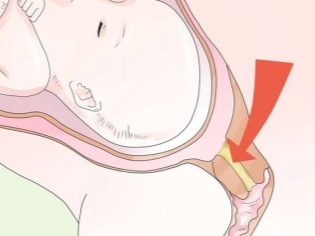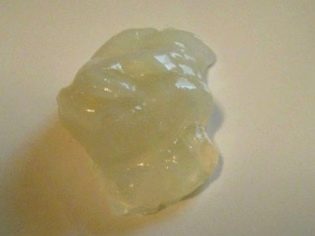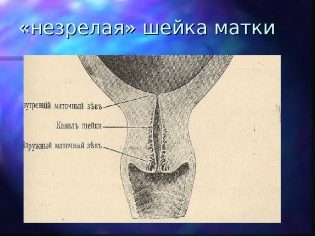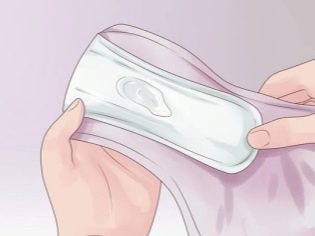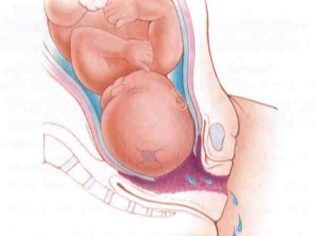What is the relationship between the discharge of the tube and the beginning of labor?
Many pregnant women believe that the discharge of mucus plug is a sure sign of the onset of labor, and therefore they start rushing to the maternity hospital if it is out, or go into prostration if the date of birth has come and the cork has not left its place.
In this article, we will look at whether there is a relationship between cork discharge and subsequent labor contractions.
Special features
The cork is formed immediately after conception. Liquid discharge, which was observed during ovulation, become thicker under the action of progesterone, and the cervical canal inside the cervix (the transition between the vagina and the uterus) narrows. He opened up to skip the sperm, but after conception the uterus needs additional protection from any penetration from the outside. The channel is closed and securely blocked by the mucous substance - the tube.
In a normal pregnancy, the stopper protects the baby throughout the pregnancy and leaves only when the need for it disappears, when there is no physiological ability to stay inside the canal. This occurs during the preparation of the cervix for childbirth, because before the contractions, the cervix should soften enough.
In the third trimester, approximately 4-6 weeks before delivery, the lower uterine segment becomes softer, and the bottom of the uterus (its upper part) becomes denser.
The baby changes position in the womb - his head is set above the entrance to the small pelvis. He is preparing to go outside. The belly goes down. From this point on, the cervix usually begins to prepare, which, as part of the reproductive female organ, cannot remain on the sidelines.
The neck is a round and rather stiff muscle. Preparation is to soften it. It occurs under the influence of a certain ratio of hormones. Hormonal background is changing rapidly, the production of relaxin begins, which relaxes the cervix and ligamentous apparatus of the uterus. A few days before the birth, the oxytocin, the pituitary and placenta, will begin to actively develop, this hormone will set the uterus in motion, stimulate its contractions.
As it softens, the cervical canal also opens slightly. Depending on the pace of preparation of the cervix, the canal may open quickly or do it very slowly. In the first case, the mucus plug, which can no longer be kept inside the canal, comes out entirely and looks like an iron clot of yellowish, transparent, pink, brownish color with or without blood veins.
With gradual discharge, a woman may notice the presence of mucous fragments in the vaginal discharge for quite a long time.
The contractions can begin only when a sufficient amount of actomyosin protein is accumulated in the cells of the uterus of myocytes. And this process is not directly related to the expansion of the cervical canal.
In this way, the traffic jam can be removed long before the onset of contractions or in their process. Fights, respectively, can begin without a traffic jam.
Sometimes the passage of the tube generally runs unnoticed by a woman. In some cases, the gelatinous substance leaves the cervical canal at the same time as the amniotic fluid during their discharge.
When to give birth?
In medicine, there is no single standard that regulates the normal or pathological periods of discharge of the mucous plug. Thus, the default is to allow its discharge 7-14 days before giving birth (gradual) or 3-7 days before the DA (single-step). It will also be perfectly normal to start contractions without moving the cork.
According to women, often the tube leaves its place in the cervical canal a couple of days before giving birth. When re-giving birth, this process usually occurs a little more rapidly - a cork can go off in 4-5 days. This is due to the fact that with repeated birth, the cervix is prepared faster, softens and smoothes more intensely and less painfully.
It is quite difficult to answer exactly the question when the contractions will begin after the cork is released. After what time the true labor pains start, depends not only on the cervical preparedness, but also on the mass of other starting factors - hormonal level, oxytocin concentration, actomyosin accumulation, psychological state of the pregnant woman, term, characteristics of the current pregnancy.
Therefore, sometimes the contractions begin as early as 30–50 minutes after the cork comes out, and sometimes it departs for a period of 38 weeks, and childbirth begins only at 40 weeks. From this point of view, it is quite difficult to navigate the discharge of the jelly-like mucus plug as a precursor of childbirth. Much more informative will be a gynecological examination of the cervix for maturity.
What to do if the cork came out?
The mucus released from the cervical canal is not a reason to immediately call an Ambulance, but it is a good reason to call your doctor or visit it on an unplanned basis to discuss a further plan of action. The doctor will assess the degree of maturation of the cervix and will tell you when it is approximately expected to start the labor.
From the moment the cork comes out, a woman should remember that now the baby is protected from viruses and bacteria, from fungi and other microorganisms that inhabit our world, only protect the fetal bladder and amniotic fluid.
In principle, the protection is powerful, but unreliable, since the same viruses and bacteria easily thin the membranes of the fetal sac, as a result of which infection can occur, premature rupture of the water and infection of the fetus, which will remain without protection at all.
Therefore, since the release of cork, it is necessary to completely limit sex life - no sexual contact, petting.
Hygiene procedures will require special attention. Toilet paper after a bowel movement can be used in the direction from the pubis to the tailbone, and in no case the opposite, in order not to carry the intestinal flora into the vagina.
Wash in the bathroom, lie in the water, swim in the pool, in standing water bodies, in the sea from the moment the cork is released. Microorganisms can enter the genital tract from water.
It is necessary to wear cotton underwear that does not squeeze the genitals, you should change the daily sanitary pad every 2-3 hours, not later. This will create the most favorable, but, alas, not sterile conditions.
In addition, after stopping a cork, a woman should not lift weights, run up and down the stairs (some try to bring the contractions up), and squat.
If the cork is out, and the degree of cervical maturity will cause questions to the doctor, a woman can be hospitalized and prescribed medication acceleration of cervical ripening - the introduction of kelp, hormonal drugs.
It should be understood that the main task is not to accelerate childbirth for the sake of childbirth, but to shorten the period when the baby stays in the womb with an increased risk of infection. The more time has elapsed since the moment the stopper has come out, the greater this risk.
If not moved away
There may be two options. Either the cork is gone, the woman simply did not notice, or she remains in the cervical canal due to the slow softening of the uterus, high levels of progesterone and low levels of estrogen.
Panic is not worth it.If the grip starts with a cork, nothing terrible will happen, because it will come out as the neck opens, it usually happens within the first 1-3 hours after the start of the latent (hidden) period of contractions.
If by some miracle the cork remains in the canal, then it will definitely leave it when the amniotic fluid is poured out under the pressure of the amniotic fluid itself. Nothing to do in this case is required. Just wait.
Some women are successfully treated by “mutetherapy”, because the sperm of men contains prostaglandins, which help soften the uterus. If there are no contraindications to intimate life, this method may well be applied.
Some help increased activity until childbirth - women clean the floors, clean, polish and beauty in the nursery, where a new family member will soon arrive. Any feasible work is welcome, the main thing is not to move the cabinet or move the piano to the next room.
If the tube does not go away before 41 weeks and the birth does not start, the woman is hospitalized, examined and a decision is made to stimulate labor activity in 41-42 weeks. After this period, according to the existing standards, pregnancy is considered post-term.
Against the background of in-hospital training aimed at a more rapid maturation of the cervix, if it is “late” for some reason, many people note that the mucus plug comes off literally one day after the start of therapy.
Childbirth at the same time can begin independently within 1-3 days. Otherwise, they are stimulated by the introduction of hormonal agents intravenously.
The opinion of experts about when it is time to go to the maternity hospital, you will learn from the following video.

